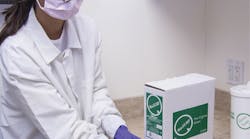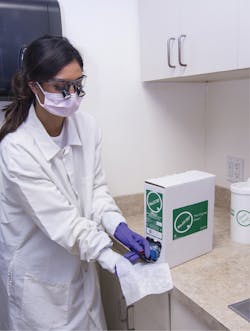Your first line of defense is still an effective surface disinfection
By Tricia Osuna, RDH, BSDH, FAADH
You don’t need me to tell you that it has been a historically deadly flu season—the news won’t let us forget it. Numerous headlines trumpeted an unsettling “first” for the Centers for Disease Control and Prevention (CDC): its first declaration of widespread flu activity across the entire United States, with the H3N2 virus blamed for at least 20 of the reported 133 flu-related pediatric deaths this season1 and claiming the lives of up to 4,000 Americans a week.2
While any health-care workplace subjects its employees to a risk of cross-infection, the occupational hazards of pathogen exposure in dentistry are only that more pronounced as a result of the number of patients we treat. Dental hygienists in particular have a significantly higher chance of vulnerability thanks to our frequent use of powered instruments that spray viruses and bacteria in the aerosols.3
It’s not just the flu we should keep on our radar either. Recently, we also heard from the CDC that a cluster of nine dental personnel was treated for idiopathic pulmonary fibrosis (IPF).4 This report’s authors also pointed the finger at occupational exposure.
Breaking the chain
We recognize three steps in the chain of cross-infection: first, the pathogens exist in sufficient number to be a threat; second, there’s a portal of exit from the patient (that’s a given!); and then third, there’s a portal of entry that leaves the dental professional vulnerable to contraction. So how do we break the chain of infection from step 2 to step 3, especially in such a bad year?
You might be tempted to believe personal protective apparel such as gloves and surgical masks are enough to break the chain; however, you’d be wrong. According to a recent study from the Canadian Center for Occupational Health and Safety, the protective material doesn’t filter out submicron particles, the edges aren’t designed to block air leakage, and they certainly can’t protect staff from inhaling pathogens and particles that remain present long after masks have been removed and discarded.5
What about staff who aren’t expected to wear protective apparel in the first place? Not just the front office staff, but also your practice’s nutritional consultants, treatment planners, or other mask-less personnel, whom some dental professionals have noticed are more likely to develop sinus problems or nasal allergies that don’t seem to plague their mask-wearing counterparts.6
This leaves the first front line of defense in our scenario, which is still disinfection. According to the CDC’s guidelines, after each patient is seen, all environmental surfaces should be wiped of debris with absorbent toweling, and then disinfected with a chemical germicide, which then must be left alone long enough to wipe out the pathogens.7 Those guidelines haven’t changed much since 2003, although 2013’s devastating breaches of protocol by one Oklahoma dentist preceded a new CDC push for practices to designate an infection prevention coordinator to oversee proper disinfection procedure.8
Still, disinfection procedure alone will not protect you, if you’re using the wrong product.
To achieve total, hard non-porous surface disinfection, these days we have a smorgasbord of antimicrobial agents at our disposal. The Organization for Safety and Asepsis Procedures (OSAP) clearly lays out what you should look for on a label before purchasing.
You might be tempted to believe personal protective apparel such as gloves and surgical masks are enough to break the chain.
First of all, it’s paramount the product be EPA-registered and approved as a hospital disinfectant.9 It must be effective against common test microorganisms such as Staphlococcus aureaus (Staph infection), Salmonella choleraesuis, and Pseudomonas aeruginosa. It’s also extremely important the product be labeled for tuberculocidal activity—effective against Mycobacterium tuberculosis (TB), as products like Lysol Brand III and Cavicide have proven to be. This is due to the TB pathogen being considered a “benchmark organism,” meaning it’s stubbornly resistant to weaker, inferior disinfectants.
However, a truly powerful surface disinfectant should be broad spectrum, fast, and active in the presence of organic matter—what’s touted as a “one-step” protocol.10 Such a disinfectant boasts short contact times, which means not just faster room turnover for the practice but also greater protection for the staff. This is where a lot of disinfectants fall out of the running. In fact, according to a 2017 issue of the Gordon J. Christensen Clinicians Report, most disinfectants couldn’t achieve a fast, broad-spectrum kill of poliovirus 1 and TB in the presence of at least 10% fresh human whole blood,11 which is a very real part of daily clinical practice. According to that report, if a chemical kills 3 log10 (99.9%) of a million organism challenge—i.e., if it can reduce a colony of 1 million bacteria to just 1,000—it can claim disinfection. And in the Christensen challenge, only the Canadian disinfectant GermXtra and the U.S. EPA-registered BioSURF actually succeeded in doing this.
In accordance with OSAP protocol, pump disinfectant sprays technically may be employed as part of the recommended “spray-wipe-spray” technique to clean and disinfect clinical contact surfaces, but these sprays can exacerbate or trigger allergic reactions from staff.12 Not only that, the spray method could be degrading the kill potential of the disinfection every time it suctions in air to dispel the liquid.
As health-care providers, we’re tasked with protecting not just our patients, but also our team members. Most patients are not even aware of what risks they’re carrying! It’s easy to grow lax on proper procedure when the threat is as invisible as infection, however the dental industry’s recent cluster of IPF cases as well as the Oklahoma tragedy serve as stern reminders that we shouldn’t. After a flu season like this one, we have all the more reason to be more watchful than ever.Tricia Osuna, RDH, BSDH, FAADH, is a University of Southern California graduate. Tricia has over 39 years of experience as a dental hygienist, and she presents courses on new products, infection control, ergonomics, oral cancer, and organ donation and recipient patient care. She is actively involved in leadership in the dental hygiene profession. She is the 2015 recipient of the American Dental Hygienists’ Association Alfred C. Fones Award for her dedication to leadership.
References
1. Ducharme J. Here’s Why the Flu Is Especially Bad This Year. TIME website. http://time.com/5105929/why-is-the-flu-so-bad-2018/ Published January 17, 2018. Accessed March 13, 2018.
2. Influenza-Associated Pediatric Mortality. Centers for Disease Control and Prevention. https://gis.cdc.gov/GRASP/Fluview/PedFluDeath.html Published March 23, 2018. Accessed March 25, 2018.
3. Harrel SK. Contaminated dental aerosols. Dimensions of Dental Hygiene. 1(6);2003:16-20.
4. Nett RJ, Cummings KJ, Cannon B, Cox-Ganser J, Nathan SD. Dental Personnel Treated for Idiopathic Pulmonary Fibrosis at a Tertiary Care Center — Virginia, 2000–2015. MMWR Morb Mortal Wkly Rep 2018;67:270–273. DOI: http://dx.doi.org/10.15585/mmwr.mm6709a2. Published March 9, 2018.
5. Hardie J. Why face masks don’t work: A revealing review. Oral Health website. https://www.oralhealthgroup.com/features/face-masks-dont-work-revealing-review/. Published Oct. 18, 2016. Accessed March 19, 2018.
6. Bell-West S. Preventing the spread of infection in dental practices. DrBicuspid website. https://www.drbicuspid.com/index.aspx?sec=sup&sub=hyg&pag=dis&ItemID=322789. Published March 6, 2018. Accessed March 9, 2018.
7. The Centers for Disease Control and Prevention. Recommended Infection-Control Practices for Dentistry. https://www.cdc.gov/mmwr/preview/mmwrhtml/00033634.htm. Published April 18, 1986. Accessed March 19, 2018.
8. Centers for Disease Control and Prevention. New Resources for Infection Prevention in Dental Settings. https://www.cdc.gov/media/releases/2016/a0329-dental-infections.html. Published March 29, 2016. Accessed March 19, 2018.
9. The Organization for Safety and Asepsis Procedures. OSAP Provides Clinical Contact Surface Disinfectant Resources - 2018 Toolkit. http://www.osap.org/page/Disinf_Info. Accessed March 26, 2018.
10. Andrews N, Kelsch N. Summary of Current Dental Surface Disinfection Protocols and a Review of the New 1 Minute Surface Disinfectants CaviCide1 and CaviWipes1. ©TotalCare 2012.
11. Gordon J. Christensen Clinicians Report. Surface Disinfection: BioSURF surface disinfectant outperforms all current competitors. Vol. 10 Issue 10. October 2017, p. 1-3.
12. The Organization for Safety and Asepsis Procedures. FAQs. http://www.osap.org/?FAQ_Instrum_Disinf2. Accessed March 27, 2018.








